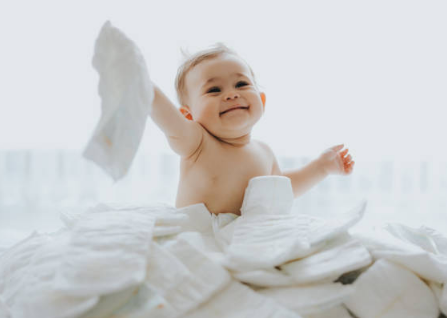Many new parents have questions about the pattern of urination in their newborns. You might be wondering, how much wet diaper should a newborn use? What color should a baby’s urine be? What should I check every time I change a diaper?
If your baby is breastfeeding regularly, their diaper production may go on as normal, but it’s still a good idea to monitor their urine output to make sure it’s safe. Since every newborn is different, the normal range of urination is also different.
If you have any questions about the amount, color or frequency of your baby’s urine, talk to your health care provider. However, in general, a newborn should have at least three diapers on the third day of life. By the sixth day, the number of wet diapers per day will increase to about six or more.

Learn more about how many diapers you should change each day to be normal and what is not.
How Many Wet Diapers Do You Use in the First Week of Life
Breastfeeding parents are often more worried about wet diapers than bottle-feeding parents. When you bottle-feed your baby, it’s easier to tell if your baby is full. However, when you’re breastfeeding, it can be a little difficult – especially in the first few days when your milk supply is increasing.
Counting the number of wet diapers is a great way to help you feel more confident that your baby is getting what they need. Here’s how many wet diapers a breastfed and bottle-fed baby can expect during the first week.
Breastfed infants
Breastfed babies change the number of diapers they wet each day during the first week of life. Your newborn may not be getting much breast milk in the first few days, so the amount of wet diapers won’t be high. Then, as time goes on, your milk supply increases, your baby will produce more urine and the amount of wet diapers will increase.
Here’s what to expect:
- Day 1: Newborns urinate for the first time within 12 to 24 hours of birth. Babies who are exclusively breastfed may not have much wet diapers in the first few hours and days of life.
- Day 2: You should check wet diapers at least twice a day until your breasts start to fill with milk on the third or fourth day postpartum; As the milk supply increases, so does the wet diaper.
- Day 3 to 5: Your baby should have at least three to five wet diapers.
- Day 6 and beyond: Your baby should wet diapers at least 6 to 8 times every 24 hours, but it could be more. Some babies will wet their diapers once every time they feed.
Bottle-fed infants
Even if you’re bottle-feeding, your baby may not consume much formula or expressed breast milk for a day or two after birth. The amount of urine excreted by newborns is directly related to the amount of fluid they consume.
If your baby eats well and drinks 2 ounces of formula every three hours from the start, you’ll see more wet diapers. However, if your newborn is drowsy or doesn’t consume much fluid on the first day or so, their diapers will get less wet.
Here are the general guidelines:
- Day 1: Your baby should change into a wet diaper for the first time 12 to 24 hours after birth.
- Day 2: You should check at least two wet diapers a day.
- Days 3 to 5: Baby should have at least three to five wet diapers.
- Day 6 and beyond: You should get at least six to eight diapers wet per day.
Urinate After the First Week
Whether you’re bottle-feeding or breastfeeding, your newborn should adjust to feeding patterns and eat well in the second week of life. You should see at least six to eight wet diapers per day, but your child may have as many as ten or more.
Some newborns will urinate up to 20 times in a 24-hour period, and that’s okay. If your baby is sleeping, you don’t have to wake them up to change diapers. A diaper change before or after each feeding (about every two to three hours) is fine.
How to Check if the Diaper Is Wet
Since newborns have very little urine and disposable diapers are highly absorbent, it can be difficult to tell if the diaper is wet and the baby is peeing enough. So, here are some ways to make sure your child is diaper-wet:
- After changing your baby’s diaper, take the diaper apart to check for moisture in the underlying or gel material. It’s okay to touch and smell diapers to check for urine.
- Place a tissue in your baby’s diaper to absorb urine and make it easier to see.
- Pour 1 ounce (2 tablespoons, 30 ml) of water into a clean, dry diaper. This will give you a better idea of what a wet diaper will look and feel like.
- Try using cloth diapers. You may find it easier to see and feel wet in cloth diapers than in disposable diapers.
- Try using disposable diapers with a humidity indicator, which has a line or a design that changes color when urine is present.

The Color of the Newborn’s Urine
Your baby’s urine should be colorless or yellowish. However, if you’re breastfeeding, you may occasionally notice some slight color changes. Certain foods, edible dyes, herbs, and vitamin supplements added to your daily diet may change the color of your milk and add a hint of green, pink, or orange to your newborn’s urine.
Concentrate urine
Concentrated urine is dark yellow. It may also have a strong odor. After breast milk production, it is normal to occasionally have diapers that concentrate urine. However, if your baby has a lot of diapers that are dark yellow, call the doctor.
Brick dust urine
Urine concentrations that are too high within a few days of birth may contain urate crystals (uric acid crystals). These urate crystals can form pink, red or orange powdery stains on your baby’s diaper, called brick ash. When you start producing more breast milk, concentrated urine and brick ash should go away on the fifth or sixth day; However, if you notice this, it’s best to consult with a pediatrician or other healthcare provider.
There Are Blood Stains on the Diaper
Both boys and girls can have a small amount of blood on their diapers, but the reasons are different. Here are two less serious reasons why you might notice bloodstains:
False menstruation: Baby girls may experience a blood-colored vaginal discharge in the first few days of life. This is called false menstruation, or false menstruation. This is caused by hormones in the baby’s body and is harmless.
Circumcision: Baby boys may have a small amount of blood in their diapers after circumcision. Circumcision bleeding usually lasts a few hours, but you may notice small blood spots in your diapers for up to a day. After circumcision, your baby should have a wet diaper within 12 hours.
When to Call a Health Care Provider
When your baby drinks enough water, they will drink at least six to eight wet diapers a day. However, if your baby doesn’t drink enough water, they may become dehydrated. Dehydration in newborns and young children is dangerous.
Your health care practitioner will check your child’s health and discuss with you how much and how often your baby is eating.
Notify your healthcare provider if:
- After the fifth day, the baby gets wet diapers less than six times a day.
- After the fourth day, the baby excretes only a small amount of dark yellow, concentrated, and foul-smelling urine.
- Your baby is unusually sleepy and has a hard time waking up.
- Your baby’s mouth and lips are dry.
- The soft spot on top of the baby’s head is sinking under the head.
- Your baby is not breastfeeding.
- After the fourth day of life, you will see traces of brick ash on the newborn’s diaper.
- General behavioral malaise.
- Excessive fatigue.
- Shortness of breath.
